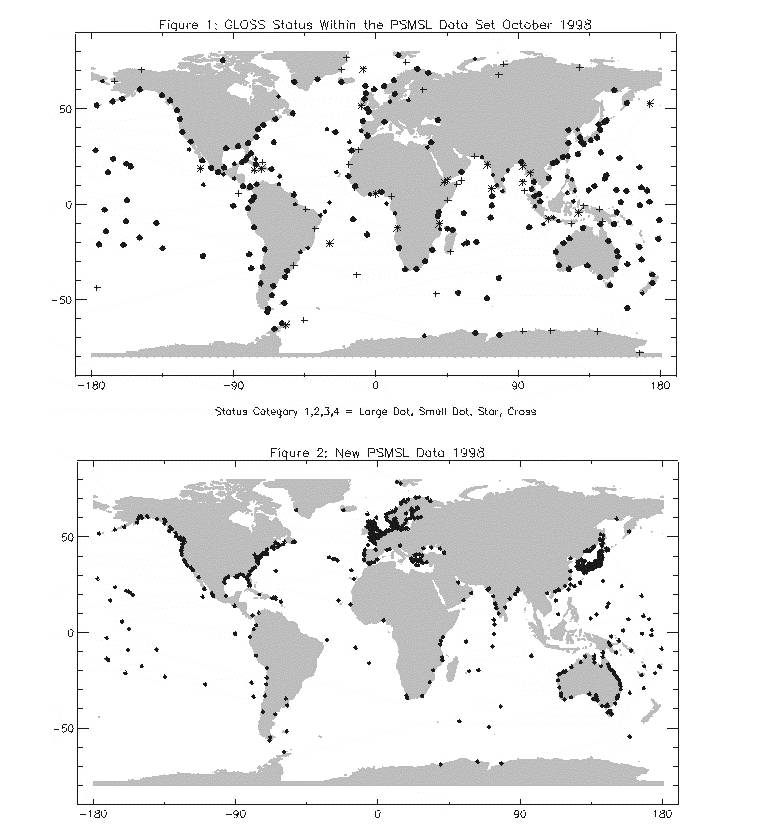
Elaine Spencer and Philip Woodworth
Permanent Service for Mean Sea Level
Bidston Observatory, Birkenhead, Merseyside L43 7RA, U.K.
The new Implementation Plan for GLOSS published in 1997 describes how the GLOSS Core Network (GCN) is intended to provide a worldwide baseline network for global sea level monitoring. The GCN consists of 287 stations around the world as shown in Figure 1. The symbols in the figure indicate which 'status category' each station falls into, using the year of the latest data entered into the Permanent Service for Mean Sea Level (PSMSL) databank as a guide:
Category 1: 'Operational' stations for which the latest data is 1994
or later;
Category 2: 'Probably operational' stations for which the latest data
is within the period 1984-1993;
Category 3: 'Historical' stations for which the latest data is earlier
than 1984;
Category 4: For which no PSMSL data exist.
A major difficulty with regard to Africa and South America is immediately
apparent. In brief, many stations in these continents are not contributing
data to the PSMSL as regularly as those from other parts of the world.
However, the situation is far from uniform. For example, the
Pacific coast of South America provides data regularly, unlike large parts
of Northeast South America. South and East Africa provide more data than
West Africa.
Figure 2 leads to similar conclusions but based on a larger number
of gauges than in the GCN. This figure shows all the stations from which
the PSMSL received data in 1998 from national sea level authorities, irrespective
of whether the stations are in the GCN or not. (These data will clearly
have been acquired by the authorities in years prior to 1998 but the data
values arrived at the PSMSL in that year). The large gaps in data
receipts from Africa and South America are similar to those of Figure 1.
The reasons for the gaps can be different in each country. For example,
in West Africa and parts of East Africa, the first issue is simply the
provision by some means of the tide gauges themselves. On the other hand,
we understand that in Brazil, for example, the gauges exist at many locations
but that the data are not being conducted routinely through processing
streams such that they are delivered finally to the PSMSL. In Venezuela,
Madagascar and some other counties, a major problem is associated with
the lack of good local GLOSS Contacts or communication links.
The remaining gaps in the GCN are unacceptable from an international
standpoint. However, they should also be unacceptable from a national point
of view as well, as local agencies will not have available the information
they need for studies of a range of coastal
processes. If help is required from other organisations (perhaps by means
of bi-lateral assistance arranged through the Intergovernmental Oceanographic
Commission), countries should not be hesitating to make the necessary links.
If training is an issue, then countries should apply to have one of their
candidates attend one of the annual GLOSS training courses.
It is to be hoped that GLOSS and associated programmes (such as the
Coastal Module of the Global Ocean Observing System) will lead to more
intensive sea level recording and research throughout Africa and South
America. The Afro-America GLOSS News is to be congratulated for publicising
progress and identifying problems in these regions.
Web Pages on GLOSS

Readers might like to keep in touch with GLOSS and other sea level information
via the PSMSL web pages at:
http://www.pol.ac.uk/psmsl/sea_level.html
and read the GLOSS Bulletin at:
http://www.pol.ac.uk/psmsl/gb.html